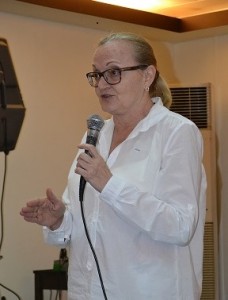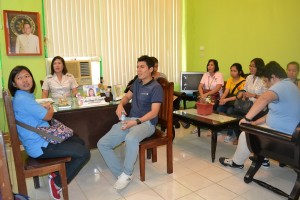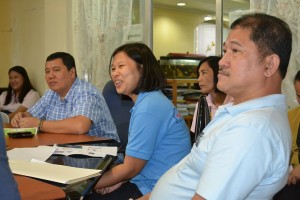
“VERY impressive.”
Such was the reaction of Aleksandra Posarac, the leader of the World Bank team who visited three towns in Region VI, after a field validation and assessment on the implementation of the Pantawid Pamilyang Pilipino Program in Region VI.
The nine-member team of the World Bank, along with staff from the National Program Management Office (NPMO) of the Department of Social Welfare and Development (DSWD), visited the municipalities of Estancia and Dumangas in Iloilo province, and Anini-y in Antique on February 26.
Posarac, who went with the team in Anini-y to witness the distribution of the cash grants to Pantawid Pamilya beneficiaries, said she was “very impressed by the systematic and orderly” conduct of the activity.
“The distribution of the cash grant was very orderly and well-run. Security was in placed. (The people) showed a very disciplined approach to the payout process,” said Posarac during the exit conference with DSWD national, regional and provincial staff in Iloilo City on February 27.
Some P1.7 million was released to 783 beneficiaries of Pantawid Pamilya in Anini-y covering Period 6 or November-December of 2013. Cash grant releases are made every two months to give time to check on the beneficiaries’ compliance to conditions on health and education.
Beneficiaries are required to undergo regular medical check-ups and for children to avail of immunizations in local health units, attend at least 85% school attendance every month, and for parents to attend the monthly Family Development Sessions (FDS).
HIGH COMPLIANCE RATE
World Bank’s Rashiel Velarde noted that in Dumangas, the beneficiaries’ compliance to health and education requirements are “very high.” As per DSWD’s 2013 records, Dumangas posted 99.19% compliance rate on education among 3-14 years old children and 98.85% compliance rate on health.
Velarde also noted the high rate of enrolment, school attendance and participation of children particularly in Dumangas Central Elementary School (DCES). The DCES has the most number of enrollees among 27 elementary schools in the municipality with more than 1,800 pupils enrolled for school year 2013-2014. Of this, 557 are Pantawid Pamilya beneficiaries.

NOTABLE CHANGE
District I Supervisor Ma. Lenny Araneta said there have been notable changes among pupils who receive assistance from Pantawid Pamilya.
“Before, these children would go to school with an empty stomach, without even a pencil, ballpen or a piece of paper. It would be the teacher who would provide these school materials to them. But because of Pantawid, they now have complete school materials. The parents could pay school fees right away whereas before, we had difficulty collecting from them,” Araneta said.
She was also proud to share that the school’s top academic awardees are Pantawid Pamilya children.
“Our last year’s valedictorian was a Pantawid beneficiary. This year, another Pantawid beneficiary has the most potential of getting the same honor,” she added.

QUALITY OF LIFE IMPROVING
For his part, Dumangas Mayor Rolando Distura said the most significant impact of Pantawid Pamilya is the improvement in the quality of life of the people.
“One can see that the quality of their life is improving. One proof of this is that more houses here now have electricity. There are more small-scale enterprises sprouting. There is also an increase in the number of permits that our local government receives for micro enterprises and licenses for transportation like tricycle,” he said.
As of this January, there are 2,461 Pantawid beneficiaries in Dumangas.
Araneta also commended the Dumangas LGU in complementing Pantawid Pamilya with local government’s programs and services and giving the beneficiaries priority to avail of these.
One such program is the adaption of the cash for work program that the LGU proposes in partnership with the Department of Labor and Employment (DOLE). Distura bared that skilled Pantawid beneficiaries will be prioritized in the said program.
CALL FOR PROGRAM’S EXPANSION
For a Pantawid Pamilya Parent Leader like Rosemarie Agsan of Brgy. Ermita, the program has been a big help for her family. With four growing children and having to depend on her husband’s meager income as a motorcycle driver on a boundary basis, every day is a struggle.
“Sang una, kada adlaw, gabakal kami bugas tag isa ka kilo tapos isda. Umpisa nga nakakuha na kami grant, makasarang na kami bisan isa ka sako nga bugas kag mas manami-nami nga sud-an pareho sang baboy kag manok para sa mga bata (Before, we would buy a kilo of rice on a daily basis and then, just fish. Since we started receiving grants, we can now afford to buy better viands like meat and chicken for the children),” Rosemarie said.
“Tani mas maglawig pa ang Pantawid bisan asta na lang makatapos mga kabataan namon sa high school (We really hope for the expansion of Pantawid until such time that our children finish high school),” Rosemarie added.
GOOD PARTNERSHIP
Posarac lauded the engagement of the DSWD with other government organizations, citing this as contributory to the laudable program implementation in the region.
For her part, DSWD6 Regional Director Ma. Evelyn B. Macapobre thanked the World Bank for its commendations and “for recognizing the efforts of the Pantawid Pamilya workers.” (DSWD6/ Alma Jornadal-Estember)
